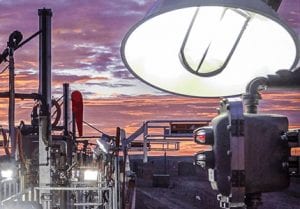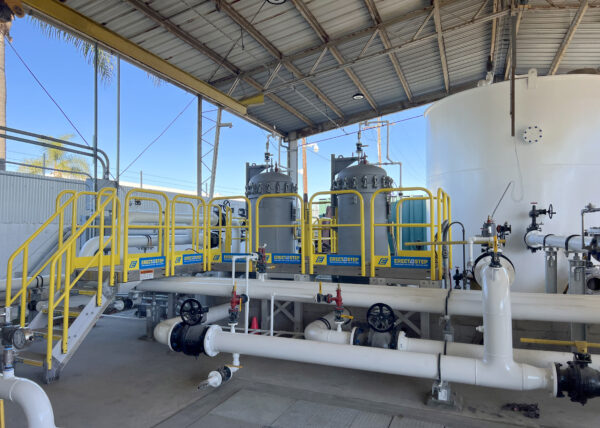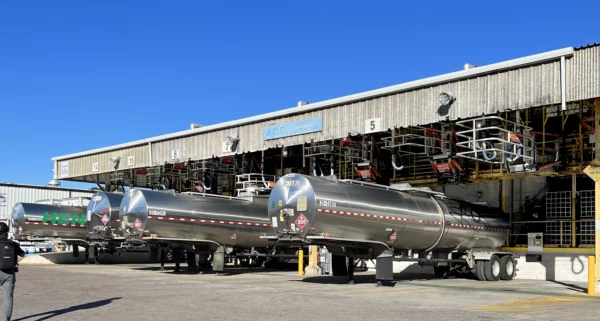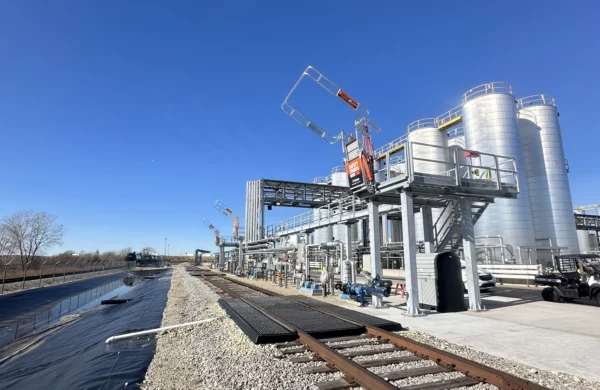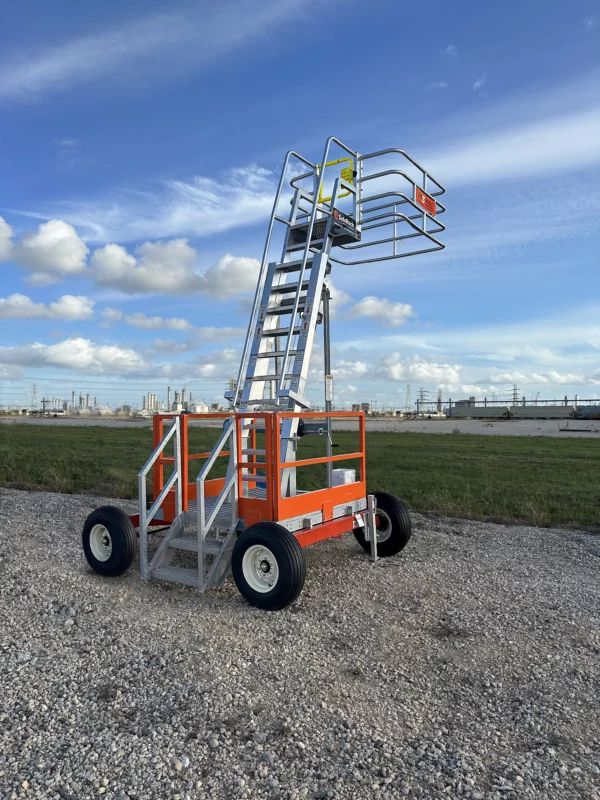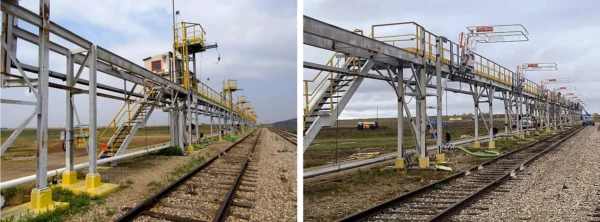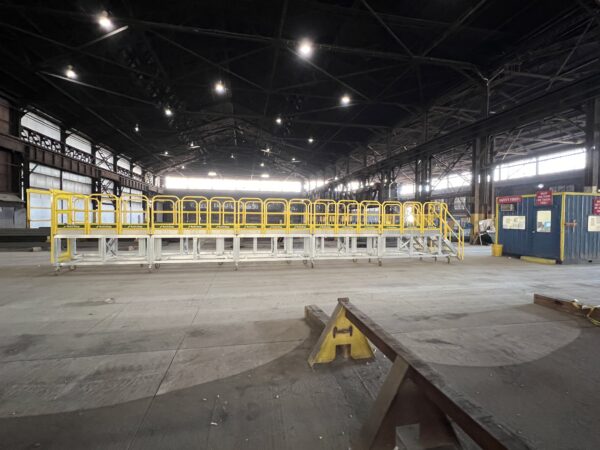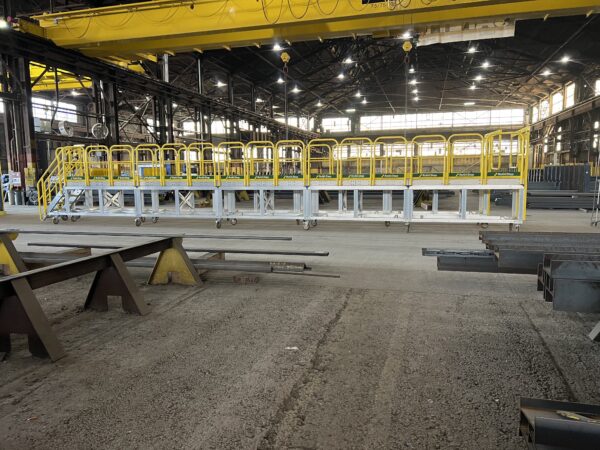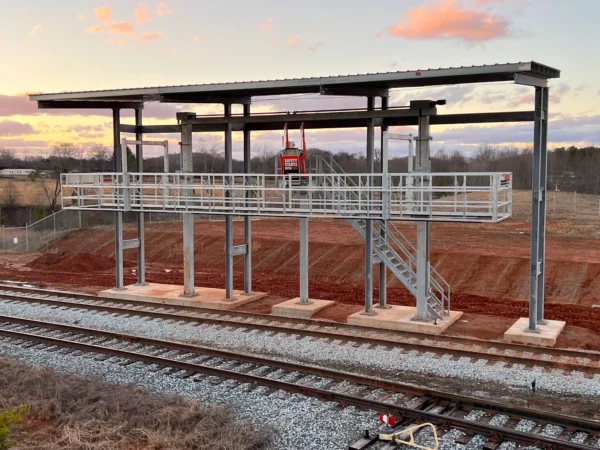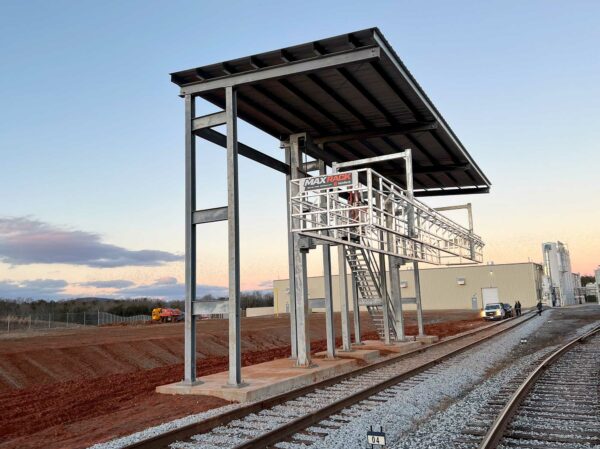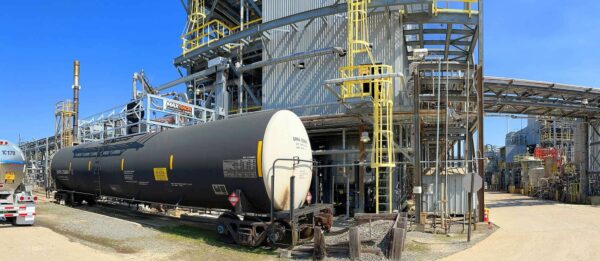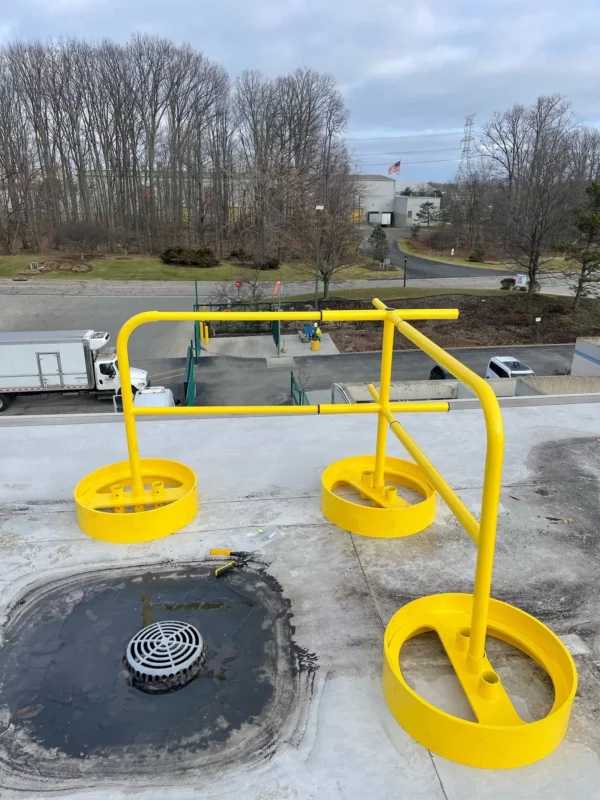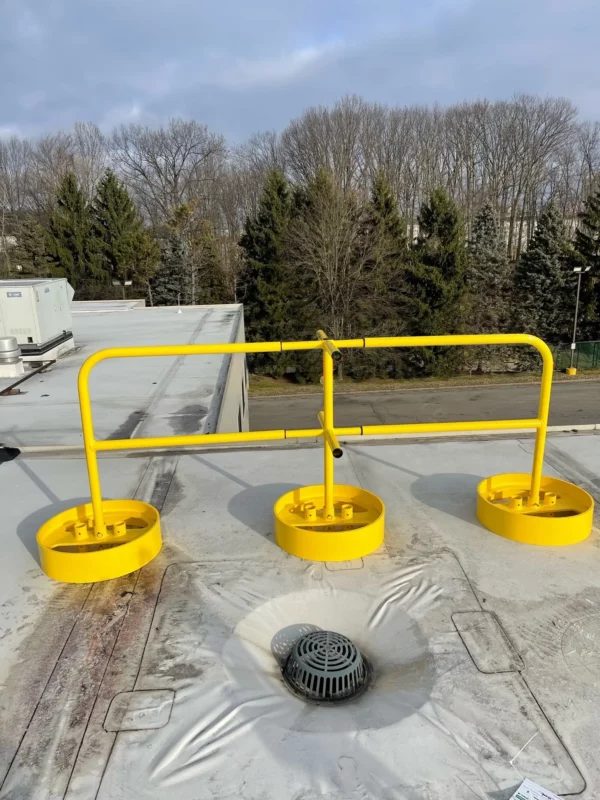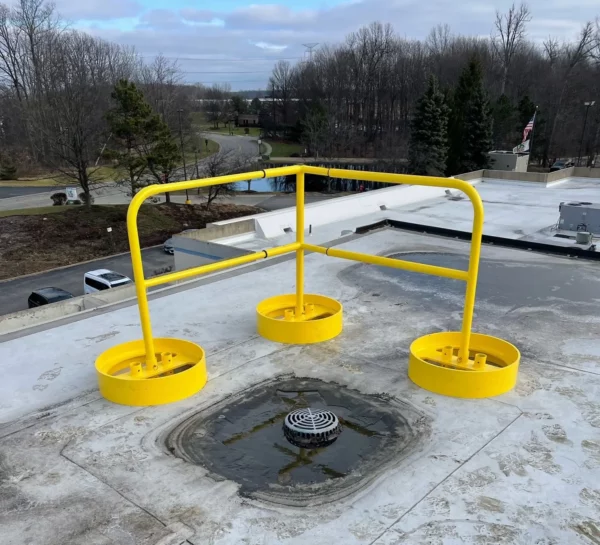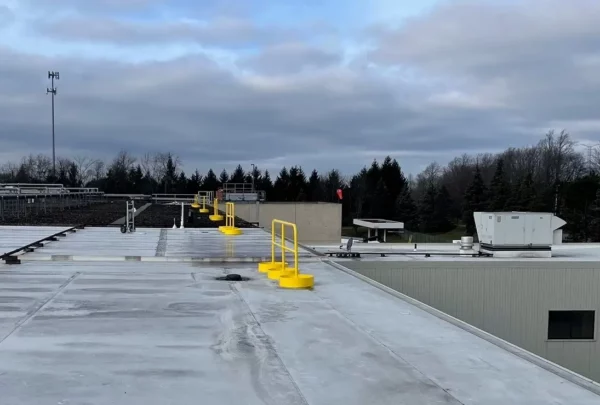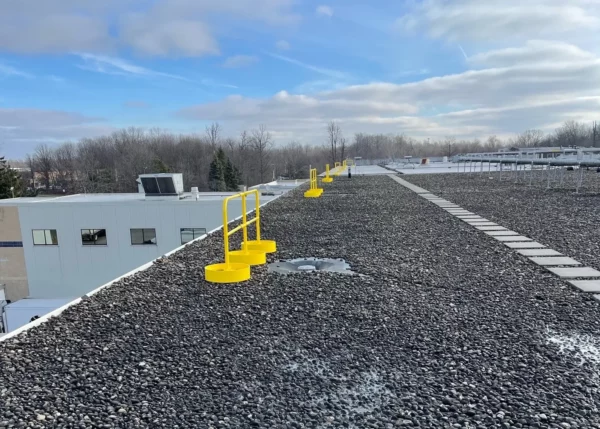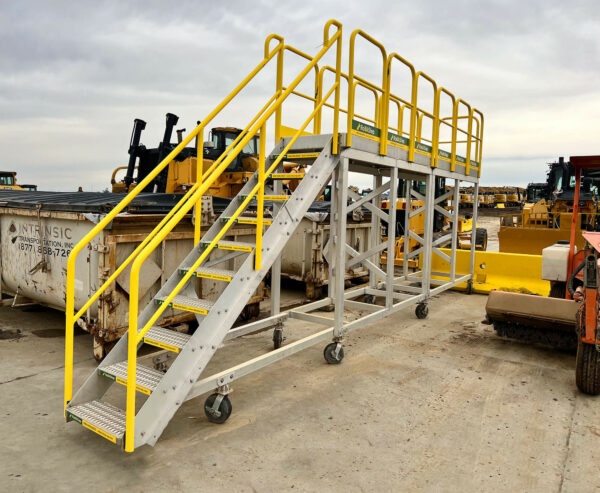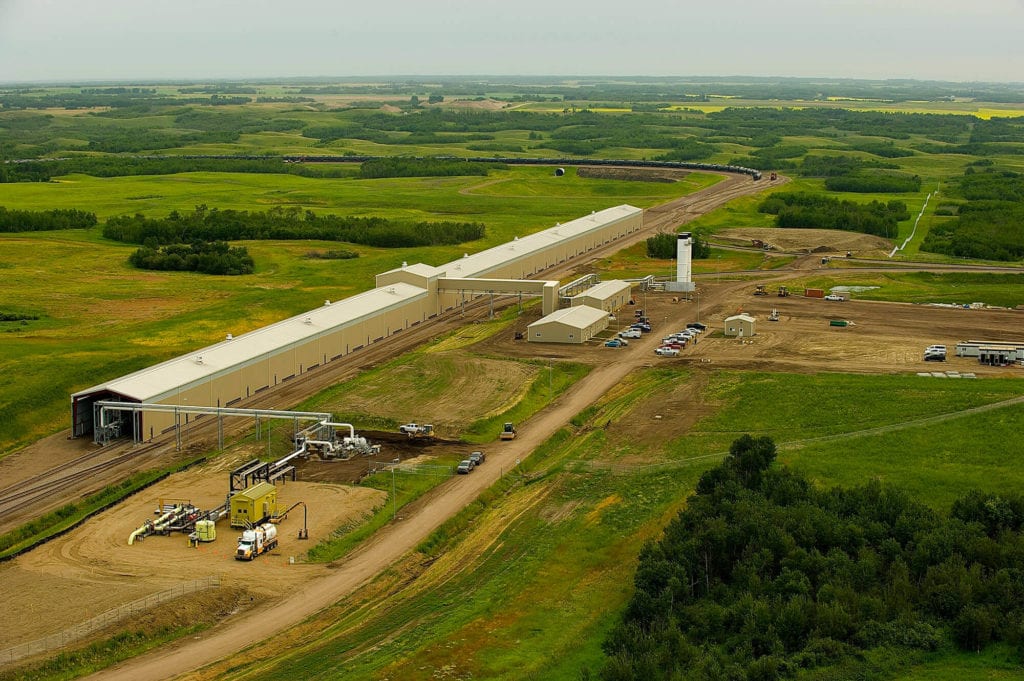Get a quote, configure a custom safety solution or ask a question. We're here to help!








- Spill ContainmentMore …Loading Safety CagesMore …
SafeRack Worldwide
We pride ourselves on one-on-one customer service. When you call SafeRack, we'll be there to answer your questions with a combined experience of 400+ years.
Select your region below.- View Products
- Railcar & Truck Loading Platforms
- Gangways & Loading Ramps
- Stairs, Platforms & Ladders
- Mobile Ladders & Platforms
- Loading Arms & Fluid Transfer
- Safety Gates & Traffic Control
- Aviation & Aerospace Access
- Marine Access & Loading
- Grounding & Monitoring
- Spill Containment
- Loading Safety Cages
- Transloaders & Skids
- Shelters & Canopies
- Fall Protection
- Terminal & Speciality
Home / Industries / Bulk Chemical Loading / CausticCaustic Handling Design, Loading, and Installation
What is Caustic? Caustic (NaOH) in all forms is highly corrosive and can cause severe burns to eyes and skin. Looking past its volatile nature you will see a versatile alkali used in the manufacture of pulp and paper, soap and detergents, chemical production, water treatment, and mining among a host of other applications.
In the United States, caustic is typically an open dome loading operation and is loaded into trucks or railcars via loading arms, chemical hoses, or bypass arms. Caustic is a strong irritant and corrosive to the skin, eyes, respiratory tract, as well as, gastrointestinal system if ingested. Personal Protective Equipment (PPE) is required to reduce and hopefully eliminate potential health risks. Since operators typically have to access hatches on top of the vehicles wearing many layers of PPE during the loading process, fall prevention is essential, not only for safety but to expedite job tasks which dramatically increases throughput.
Caustic is typically transported in 16,300 to 18,400 gallon coiled and insulated tank cars
Tank cars must meet the DOT 111A100W1 specification for the transportation of sodium hydroxide (caustic soda), potassium hydroxide and other like commodities. The rails cars themselves are ~ 9′ outside diameter with an overall length of ~39′ to 45′, with an offset opening and 7’4″ long x 6′ wide crashbox.
Caustic is typically bottom unloaded from the tank car by either gravity or compressed air connected to a flexible chemical hose or bottom unloading arm.


















Question, Get a Quote, Live Demo or Request an On-Site Visit
Our experts simplify the complex
View Full TextYour Project
Typically, as a starting point, we will need to know answers to these questions for your project
- The Railcar connection locations need flexibility – Do you know what the breadbasket connections look like?
- Are you using liquid and vapor arms/hose as two separate devices or a piggyback arm?
- Is the loading station indoors or outdoors?
- Is the loading area temperature controlled?
- How are you going to spot your railcars
Our highly trained technical sales team will undertake a detailed site survey prior to undertaking any work to check and clarify all dimensions, obstructions, access issues and other salient points. Our challenge is to provide the safest working environment – protecting operators and the equipment – while simultaneously enabling you to improve throughput and productivity.
Your Project Needs
Whether you are looking for a turn-key installation, on-site supervision or a maintenance program, SafeRack is positioned to assist you. We can do as little or as much as you need. Our project management and supervision team is the best in the business at supporting your company’s needs.
- Collaborative Design – Our loading platform specialists will work with you one on one, if you design to design the best loading solution for your specific needs
- Contract review – drawings and associated documents relating to the contract prior to site arrival
- Risk Assessment – Undertaking a site risk assessment
- Shipment Inspection – Detection of any shipping damage or abnormalities
- Material Receiving – Supervised off-loading and transport at site
- Installation Management – Supervised Installations and Coordination
- Start-up & Commissioning – On-site training for both users and maintenance personnel
Loading Arms
Generally speaking, SafeRack recommends rigid pipe loading arms where possible for the following reasons:
- Balanced throughout their movement envelope
- Designed not to hit the ground – protecting the asset and the operator
- Ergonomic – one man operation
- Fitted with manual or actuated valves.
- Fitted with optional purge/vent facilities
- Can be moved into position with ease and left hanging in the air while the operator prepares the tanker connection
- Parked neatly
Hoses require:
- Annual pressure test
- Are difficult to stow neatly when not in use
- Can be dropped
- Can be driven over
- Are very heavy to use if fitted with a valve at the tanker connection point
- Cannot be easily heated or have vent/purge valves fitted to it
- Prone to catastrophic failure
Tank truck (un)loading procedures are similar to railcar applications with the trailers meeting established DOT requirements for hauling liquid caustic soda. Bottom unloading is also the preferred method for unloading caustic tank trucks utilizing a 2” or 3” chemical hose or gravity drop bottom unloading arm with a quick release coupler or dry disconnect fitting and break-away.
Carbon steel is the most commonly used material of construction for caustic soda at low to moderate temperatures, with an ideal storage temp of 80 to 100 degrees F. Temperatures above 120 degrees will cause accelerated corrosion of the carbon steel and contaminate the caustic soda. When iron contamination or corrosion is unacceptable, epoxy lined carbon steel or 316L or 304L stainless steels are recommended. At temps above 200 degrees Nickel or Hastelloy can also be used.
Caustic soda will corrode metals, such as aluminum, tin, and zinc. During this process, it generates hydrogen, which has the potential to behave as an explosive gas so extreme care should be taken when handling or transporting.
Typical Caustic Loading Platform
Quote or discuss your installation.
Start by selecting loading application"*" indicates required fields
Below are some of the loading and unloading solutions for illustrative purposes only. Our experts will work with you and your team for a custom solution to suit your needs.
Caustic Loading Arms


Caustic is typically splash loaded into railcars and tank trucks via loading arms or chemical hoses. The current best loading practice is to use a 3″ carbon steel or stainless steel arm for tank trucks with PTFE or ChemRaz seals. Vapor recovery is optional and is used in conjunction with a splash plate, vapor cone, or inflatable hatch seal. Railcar loading will use a similar setup as trucks but with a 4” arm as higher flow rates must be obtained to load the higher capacity vehicles at an acceptable rate.
The loading arms layout will ensure that it is self-draining after use as to completely evacuate product when the arm is stored to reduce product leakage which could injure passer-bys and corrode platform, support, and process piping located on the rack. Safety options such as high-level sensors/probes can be added to the arm to switch off loading should the level hit a predetermined height in the vehicles.
Example of gravity fed top loading arm:

CAUSTIC UNLOADING ARMS
These are generally 4”, carbon steel, ANSI 150Lb rated loading arms, that will be fitted with quick-couplings and an emergency break-away unit. The arm itself will be fitted to a support standpost, and will be self-draining in design.
We would also recommend that the arm be fitted with a parking latch and parking sensor to ensure that the arm is stored in a safe place when not in operation.
Example of a gravity fed bottom unloading arm


Caustic Gangways and Safety Cages

Since caustic rail cars have off-set crash boxes SafeRack recommends a wider telescoping access gangway (48″-60″ is preferable) as it helps improve access and egress to and from the railcar. In addition, a wider gangway will reduce the risk of the operator’s PPE getting caught, torn or damaged, and will improve productivity and safety. Powered gangway solutions are also an option, with both hydraulic and pneumatic solutions being commonly used. Each gangway will be fitted with a two-rail safety cage for the railcar crash box. This will be a centered 7’6”x 6’ safety cage to sit directly over the cashbox; and will provide a safe, secure work environment for your operator when accessing hatches on railcars.
For tank truck applications (loading or unloading) SafeRack’s standard 24” wide Self-Adjusting (SAS) gangway with a deeper 4’x6’x4-rail safety cage would be the preferred solution.
GX SELF-ADJUSTING STAIR (SAS) GANGWAY
SafeRack’s NEW GX SAS gangways use Retractalok power-assist technology allowing operators to raise or lower effortlessly, light as a feather to lift, solid as a rock. Tested in the most critical applications, this revolutionary new gangway outperforms all others. Available in multiple lengths and widths. Learn More

SafeRack’s GX SAS gangways use Retractalok power-assist technology allowing operators to raise or lower effortlessly, light as a feather to lift, and solid as a rock. Tested in the most critical applications, this revolutionary new gangway outperforms all others. Available in multiple lengths and widths.
Learn MoreMAXRack Elevating Safety Cage
 As an alternative to our two and four-rail safety cages, some customers prefer our MAXRack elevating safety cages. The ultimate fall prevention solution engineered to keep operators safe and productive. Designed for both trucks or railcars, and available in multiple cage lengths and widths. Safe, durable, and easy to use. MAXRack is built rock-solid with galvanized steel column supports and lifting arms (cages can be Aluminum, Galvanized, or Stainless Steel depending on application) Available in two power options – Pneumatic Air Drive and Electric Drive (Explosion and Non-Explosion Proof).
As an alternative to our two and four-rail safety cages, some customers prefer our MAXRack elevating safety cages. The ultimate fall prevention solution engineered to keep operators safe and productive. Designed for both trucks or railcars, and available in multiple cage lengths and widths. Safe, durable, and easy to use. MAXRack is built rock-solid with galvanized steel column supports and lifting arms (cages can be Aluminum, Galvanized, or Stainless Steel depending on application) Available in two power options – Pneumatic Air Drive and Electric Drive (Explosion and Non-Explosion Proof).
Learn Morefeatures a slip-resistant walk surface and, with the use of the telescoping extension, eliminates gaps on narrow railcars. Learn More
Caustic Eye Wash/Drench Showers

ANSI guidelines state that an Eye Wash/Drench Showers need to be located 10 seconds or 55′ (16.8m) from contaminants or hazardous materials. Eyewash stations need to be on the same horizontal plane with no obstructions. Therefore, we would propose the installation of a standard combination Drench Shower/Eyewash Unit, which will save limited space and fit easily into any work environment.
This is a fundamental safety requirement for any caustic loading or unloading station.
Caustic Spill Containment

Spill containment pans will be provided at the point of loading operations and is an essential piece of equipment in overall site safety and environmental protection. SafeRack recommends a minimum 20’ long galvanized, polyethylene or composite track pan to mitigate spills. Caustic Grounding

While Caustic is not flammable, industry best practice includes the grounding of all vessels before starting the (un)loading process. - Vehicle grounding and bonding — ensure true grounding before product flow is permitted
- Explosion-proof enclosures — meet or exceed UL, CSA and Ex requirements
Caustic Safety Gates

Safety Gates will be installed at the top of stairs and any other openings to ensure operator safety at all times.  YellowGate Safety Gates
YellowGate Safety GatesSafeRack’s line of industrial safety gates is the most flexible product on the market with the ability span openings between 16” and 36” and is field adjustable with nothing more than a wrench. Learn More
Caustic Options

- Lighting – Lighting both over and under the platform will be provided. For overcast days or second shift, lighting is essential for improved safety and improved productivity.
- Platform & Canopies – Full platform canopies reduce exposure to the elements and improve the safe and productive loading operation from the operator’s perspective.
- Operator Shelter – Depending on your site requirements, consideration should be given to the requirement of an operator or guard building on the loading platform. This can be customized to meet specific site requirements.
- Wheel Chocks – Railcar Wheel Chocks provide fast blocking of all types of railcars and meet OSHA regulations to safely prevent railroad cars from moving during loading or unloading operations. This is a requirement by the Department of Homeland Security.
Personal Protective Equipment PPE Requirements
Eye/Face Protection: Wear chemical safety goggles. A face shield (with safety goggles) may also be necessary.
Skin Protection: Wear chemical protective clothing e.g. gloves, aprons, boots. Wear a chemical protective, full-body encapsulating suit.
Use a local exhaust ventilation and enclosure, if necessary, to control the amount in the air. Consider using a corrosion-resistant exhaust ventilation system separate from other ventilation systems. It may be necessary to use stringent control measures such as process enclosure to prevent product release into the workplace. Use backup controls (e.g. double mechanical pump seals) to prevent the release of this material due to equipment failure. * For illustrative purposes only. Our experts will work with you and your team for a custom solution to suit your needs Caustic 101
Things to know about Caustic

Liquid caustic soda is regulated by the U.S. Department of Transportation (DOT) and is classified as a corrosive material, with the DOT identification number UN 1824.
Caustic soda solution, also known or referred to as Sodium Hydroxide, Lye, or Potassium Hydroxide, and is a very corrosive industrial chemical. Liquid caustic soda is transported as a 50% solution with the balance being water.
When caustic soda is diluted into a liquid it generates a considerable amount of heat, and the resulting solution may spatter, so considerable care must be taken when handling. While it does not look dangerous, having the appearance of water, eye contact of only a few seconds can cause permanent damage, including blindness.
Caustic soda is odorless, so odor cannot serve as a warning. In addition, caustic soda doesn’t cause immediate pain when it comes in contact with the skin, but it does cause immediate damage. Brief contact with the skin may cause marked irritation or a chemical burn
Upon bodily contact, caustic soda will continue to attack and penetrate the eyes or skin (unlike acids that coagulate protein to form a barrier).
Caustic chemicals are frequently used in facilities such as:
- Bulk paper plants
- Chemical plants
- Soap and detergent manufacturers
- Refineries
Customer Reviews
 4 5The best in the field.
4 5The best in the field.I don’t like buying over the phone but you guys make it pleasant, and your staff is very knowledgeable (the best in the field ).
By Juan Garza from Pacific Ethanol Magic Valley LLC on 2/8/13 5 5Excellent!
5 5Excellent!The quality is above the rest, easy to install, adjustability is excellent. Any company in the market for swing gates go with YellowGate for great service.
By Jeff Price from TransCanada Columbia Midstream on 1/20/19 4 5Delivery was faster than expected.
4 5Delivery was faster than expected.Customer service was prompt with quote. Sales was very thorough. Delivery was faster than expected. Price was right on target.
By Scott Rowe from SRS Distribution on 11/19/13 4 5Everything was good from start to finish.
4 5Everything was good from start to finish.This product’s quality is better than we had before. It was delivered on time, Mark Gardner worked with me along the way, everything was good from start to finish.
By Jim Orlinski from Cargill Salt on 11/7/11 5 5Only took a few days. Great service!
5 5Only took a few days. Great service!We value people at our company, and we want everyone going home safe. The cost of the product is a whole lot cheaper than days away from work, pain and suffering and missed enjoyment of your employees home life. I’m really pleased.
By Michael Duff from Kinder Morgan on 2/15/18 5 5Very responsive and helpful.
5 5Very responsive and helpful.Our crew used them immediately and are grateful they arrived so quickly. Tom and Amber are always quick to respond to any question we might have. They are the ‘go’ to team.
By Kerri Zabin from Arc Terminals on 7/27/17
Is your plant or facility compliant with ANSI, OSHA, and local safety codes? We can help!


EMERGENCY EYEWASHES / SHOWER EQUIPMENT AND THE ANSI/ISEA Z358.1 – 2014 STANDARD
Following eye contact, you must start washing with water immediately to prevent permanent damage. In the event of skin contact, you must start washing with water immediately to prevent slow-healing chemical burns.
Are you aware that ANSI guidelines state that Eye Wash/Drench Showers need to be located 10 seconds or 55′ from contaminates or hazardous materials and located on the same horizontal plane, with no obstructions? If bottom loading/unloading, an additional shower should be located at grade as well. SafeRack provides the above equipment plus much more needed to keep employees safe and expedite bulk chemical loading and unloading.
OSHA Regulation Experts – Does your existing chemical safety equipment or chemical loading systems meet OSHA’s latest requirements? SafeRack’s professional technical sales consultants are available to meet with your team to make recommendations to keep your facility in front of OSHA’s ever-changing country and region-specific standards and regulations, including lifeline and trolley beam fall arrest systems, metal stairs, and access platforms.
Why SafeRack?
The SafeRack approach is a collaborative one. Let’s call it The SafeRack Way. We have, over many years amassed a great deal of experience and understanding of the safety aspects involved in loading road tankers and railcars, as well as the behavioral habits of the operators.

Experts In Chemical Loading
- Acetic Acid
- Acetic Anhydride
- Acetonitrile
- Acrolein
- Acrylic Acid
- Acrylonitrile
- Aluminum Chloride
- Aluminum Sulfate
- Ammonia
- Ammonium Hydroxide
- Ammonium Nitrate
- Aniline
- Benzene
- Benzyl Chloride
- Bromotrifluoromethane
- Butadiene
- Carbon Dioxide
- Caustic
- Chlorine
- Chloroform
- Chlorosulfonic Acid
- DEF (Diesel Exhaust Fluid)
- Diethylene Glycol
- Dimethylformamide
- Dodecylbenzene Sulfonic Acid
- Ethanol
- Ethyl Acetate
- Ethyl Chloride
- Ethylene
- Ethylene Dichloride
- Ethylene Glycol
- Ethylene Oxide
- Ferric Chloride
- Ferrous Chloride
- Hexane
- Hydrochloric Acid
- Hydrofluoric Acid
- Hydrofluorosilicic Acid
- Hydrogen Cyanide
- Hydrogen Peroxide
- Hydrofluoric Acid
- Hypochlorous Acid
- Isopropyl Acetate
- Liquid Argon
- Liquid Nitrogen
- Liquid Oxygen
- Maleic Anhydride
- MDI
- Methanol
- Methyl Chloride
- Methyl Ethyl Ketone
- Methyl Methacrylate
- Methyl Isocyanate
- Molten Sulphur
- Nitric Acid
- Oleum
- Phenol
- Phosphoric Acid
- Phosphorus Oxychloride
- Phosphorus Trichloride
- Polypropylene
- Renewable Diesel
- Sodium Cyanide
- Sodium Hydroxide
- Sodium Hypochlorite
- Styrene Monomer
- Sulfuric Acid
- Sulfur Dioxide
- Titanium Tetrachloride
- Toluene
- Toluene Diisocyanate
- Turpenitne
- UAN (Urea Ammonium Nitrate)
- UREA
- Vinyl Acetate
- Vinyl Chloride
- Xylene
- Zinc Chloride
- Agro-Chemical
- Specialty Chemical
- Petrochemical

North America’s largest loading terminal
World-leading designer, manufacturer, and installer of truck and railcar loading platforms
As one of the primary railcar loading points, Hardisty is one of the major crude oil hubs in North America and a major origination point of pipelines that export to the United States. SCS was asked to supply and construct a SafeRack crude oil loadout terminal spanning nearly half a mile. The USD Hardisty terminal can load up to two 120-railcar unit trains per day and consists of a fixed loading rack with 62 railcar loading positions enclosed, separate control, operator, and mechanical buildings, as well as a unit train staging area and loop tracks capable of holding multiple unit trains simultaneously. SCS also supplied and installed boom-supported loading arms with supply and vapor management systems.

Quick Quote 866-761-7225
LET US DESIGN YOUR SOLUTION TODAY
Our innovative tools provide 3D visualizations and accurate quotes in minutes.
Get Help NowOrder Now 866-761-7225
Questions or Need a Quote?
Chat live with a knowledgeable and friendly safety expert now.

Bob Kashtan
Located in South Carolina

Joey Robinson
Located in South Carolina

Caelin Lacy
Located in South Carolina

Katie Kelly
Located in South Carolina

Amber Graham
Located in South Carolina
















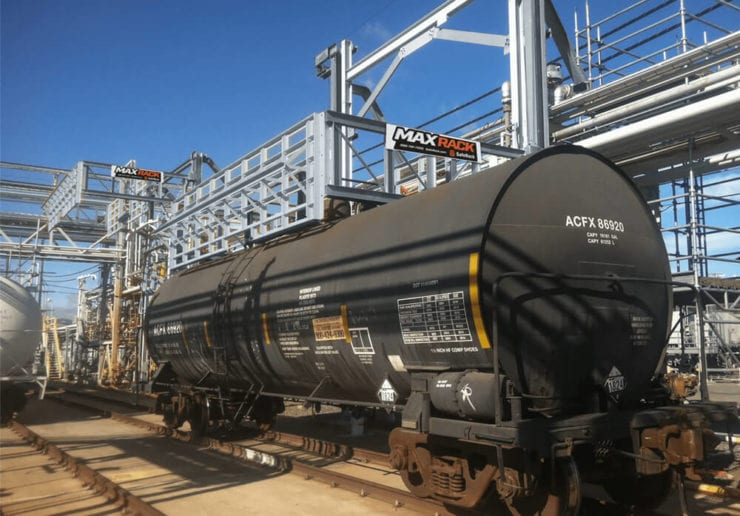

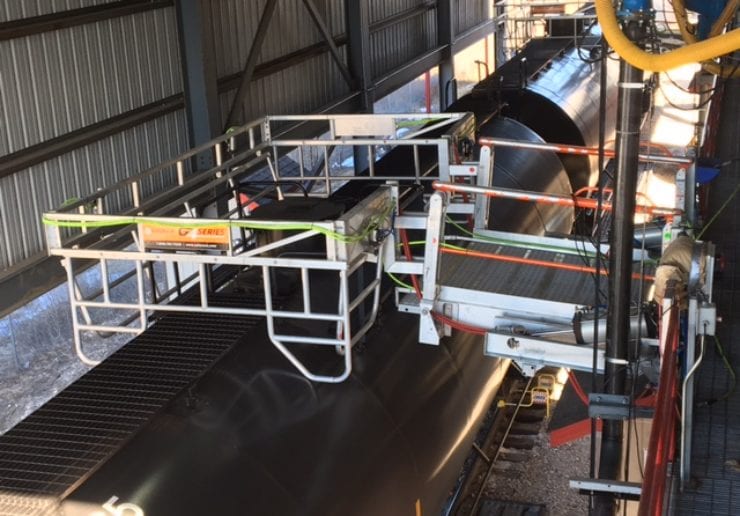

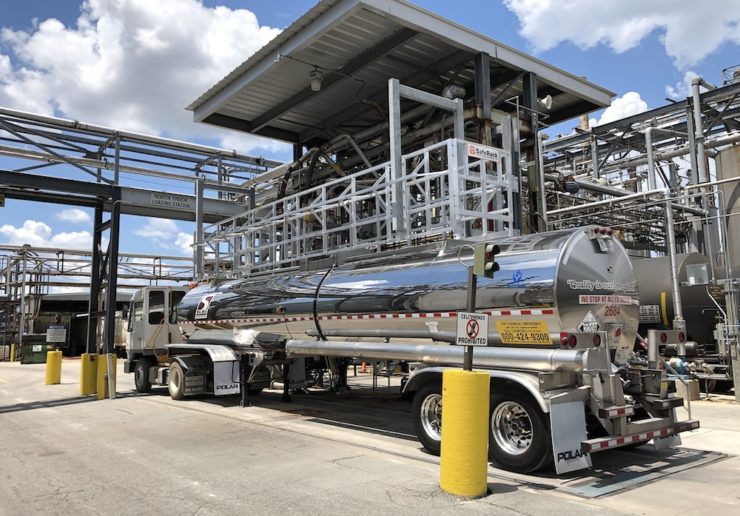




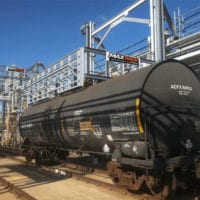
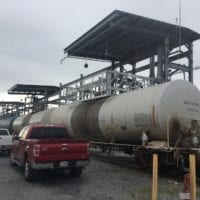
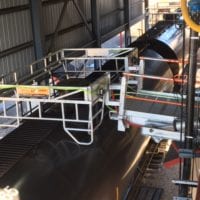

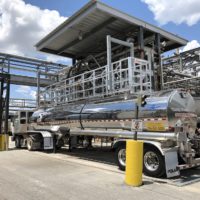

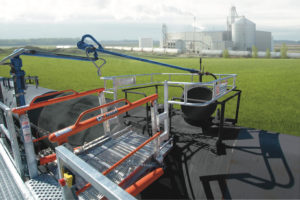




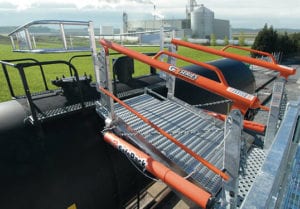
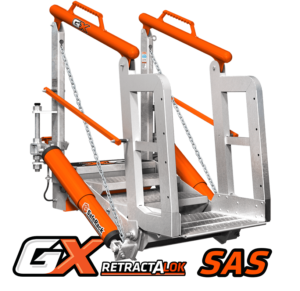
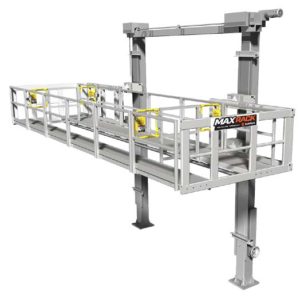 As an alternative to our two and four-rail safety cages, some customers prefer our MAXRack elevating safety cages. The ultimate fall prevention solution engineered to keep operators safe and productive. Designed for both trucks or railcars, and available in multiple cage lengths and widths. Safe, durable, and easy to use. MAXRack is built rock-solid with galvanized steel column supports and lifting arms (cages can be Aluminum, Galvanized, or Stainless Steel depending on application) Available in two power options – Pneumatic Air Drive and Electric Drive (Explosion and Non-Explosion Proof).
As an alternative to our two and four-rail safety cages, some customers prefer our MAXRack elevating safety cages. The ultimate fall prevention solution engineered to keep operators safe and productive. Designed for both trucks or railcars, and available in multiple cage lengths and widths. Safe, durable, and easy to use. MAXRack is built rock-solid with galvanized steel column supports and lifting arms (cages can be Aluminum, Galvanized, or Stainless Steel depending on application) Available in two power options – Pneumatic Air Drive and Electric Drive (Explosion and Non-Explosion Proof).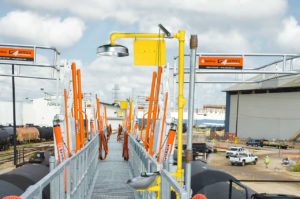
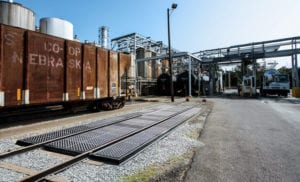
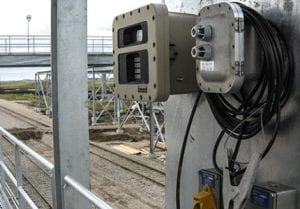
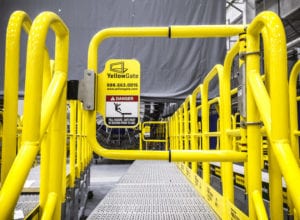
 YellowGate Safety Gates
YellowGate Safety Gates